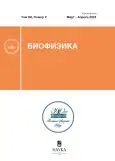Prevention of Mitochondrial Dysfunction with 2-Ethyl-6-Methyl-3-Hydroxypyridine Carnitinate
- Authors: Zhigacheva I.V1, Rusina I.F2, Krikunova N.I1, Kuznetsov Y.V1, Rasulov M.M3, Yakovleva M.A1, Goloshchapov A.N1
-
Affiliations:
- N.M. Emanuel Institute of Biochemical Physics, Russian Academy of Sciences
- N.N. Semenov Federal Research Center for Chemical Physics
- State Scientific Center “State Research Institute of Chemistry and Technology of Organoelement Compounds”
- Issue: Vol 69, No 2 (2024)
- Pages: 294-302
- Section: Articles
- URL: https://journals.rcsi.science/0006-3029/article/view/257578
- DOI: https://doi.org/10.31857/S0006302924020105
- EDN: https://elibrary.ru/OUCNRP
- ID: 257578
Cite item
Full Text
Abstract
About the authors
I. V Zhigacheva
N.M. Emanuel Institute of Biochemical Physics, Russian Academy of Sciences
Email: zhigacheva@mail.ru
Moscow, Russia
I. F Rusina
N.N. Semenov Federal Research Center for Chemical Physics
Email: rusina939@mail.ru
Moscow, Russia
N. I Krikunova
N.M. Emanuel Institute of Biochemical Physics, Russian Academy of SciencesMoscow, Russia
Yu. V Kuznetsov
N.M. Emanuel Institute of Biochemical Physics, Russian Academy of SciencesMoscow, Russia
M. M Rasulov
State Scientific Center “State Research Institute of Chemistry and Technology of Organoelement Compounds”
Email: rasulovmaksud@gmail.com
Moscow, Russia
M. A Yakovleva
N.M. Emanuel Institute of Biochemical Physics, Russian Academy of SciencesMoscow, Russia
A. N Goloshchapov
N.M. Emanuel Institute of Biochemical Physics, Russian Academy of SciencesMoscow, Russia
References
- Воронина Т. А. Мексидол: основные нейропсихотропные эффекты и механизм действия. Фарматека, 6, 28–31 (2009).
- Коробкин М. В., Пашин Е. Н., Бобер К. Е., Покровский М. В., Рагулина В. А., Артюшкова Е. Б., Покровская Т. Г., Корокина Л. В., Цепелев В. Ю. и Даниленко Л. М. Изучение эндотелиопротективного и коронарного действия производных 3-оксипиридина. Кубанский науч.-мед. вестн., 109 (4), 137–140 (2009).
- Бугрова М. Л., Абросимов Д. А. и Яковлева Е. И. Влияние мексидола на мозговой натрийуретический пептид кардиомиоцитов в постреперфузионном периоде в эксперименте. Современные технологии в медицине, 7 (3), 40–47 (2015). doi: 10.17591/stm2-15.7.3.05
- Дюмаев К. М., Воронина Т. А. и Смирнов Л. Д. Антиоксиданты в профилактике и терапии патологий ЦНС (Изд-во Ин-та биомедицинской химии РАМН, М. 1995).
- Surai P. Carnitine Enigma: From antioxidant action to vitagene regulation. Part 2. Transcription factors and practical application. Veterinary Sci., 2 (1), 66–84, (2015). doi: 10.13188/2325-4645.1000018
- Шляпинтох В. Я., Карпухин О. Н., Постников Л. М., Захаров И. В., Вичутинский А. А. и Цепалов В. Ф. 1966. Хемилюминесцентные методы исследования медленных химических процессов (Наука, М., 1966).
- Каркищенко Н. Н. и Грачевой С. В. Руководство по лабораторным животным и альтернативным моделям в биомедицинских исследованиях (Профиль, М., 2010).
- Mokhova E. N., Skulachev V. P., and Zhigacheva I. V. Activation of the external pathway of NADH oxidation in liver mitochondria of cold-adapted rats. Biochim. Biophys. Acta, 501, 415–423 (1977). doi: 10.1016/0005-2728(78)90109-3
- Fletcher B. I., Dillard C. D., and Tappel A. L. Measurement of fluorescent lipid peroxidation products in biological systems and tissues, Anal. Biochem., 52, 1–9 (1973). doi: 10.1016/0003-2697(73)90327-8
- Carreau J. P. and Dubacq J. P. Adaptation of a macroscale method to the micro-scale for fatty acid methyl transesterification of biological lipid extracts. J. Chromatogr., 151 (3), 384 (1979). doi: 10.1016/S00219673(00)88356-9Get
- Wang J., Sunwoo H., Cherian G., and Sim I. S. Fatty acid determination in chicken egg yolk: a comparison of different methods. Poult Sci., 79 (8), 1168 (2000). doi: 10.1093/ps/79.8.1168
- Golovina R. V. and Kuzmenko T. E. Thermodynamic evaluation of the interaction of fatty acid methyl esters with polar and non-polar stationary phases, based on their retention indices. Chromatography, 10 (9), 545 (1977).
- Каркищенко В. Н., Каркищенко Н. Н., Шустов Е. Б., Берзин И. А., Фокин Ю. В. и Алимкина О. В. Особенности интерпретации показателей работоспособности лабораторных животных по плавательным тестам с нагрузкой. Биомедицина, 4, 34–46 (2016).
- Островская Р. У., Клейменова Н. Н., Камышева В. А., Молодавкин Г. М., Яворский А. Н. и Бойко С. С. В кн. Фармакологическая коррекция утомления, под ред. Ю. Г. Бобкова (Медицина, М., 1982), сс. 39–42.
- De Carvalho C. C. C. R., and Caramujo M. J. The Various roles of fatty acids. Molecules, 23 (10), 2583 (2018), doi: 10.3390/molecules23102583
- Danilenko L. M., Skachilova S. Ya., Nadezhdin S. V., Timokhina A. S., Shcheblykina O. V., and Kotelnikova A. S. Pharmacological screening of substances with cardioprotective effect in the group of 3-oxypyridine derivatives. Res. Result: Pharmacol., 4, 125–131 (2018). doi: 10.3897/rrpharmacology.4. 28414
- Волчегорский А., Синицкий А. И., Мирошниченко И. Ю. и Рассохина Л. М. Влияние производных 3-оксипиридина и янтарной кислоты на активность моноаминоксидаз in vitro. Хим.-фармацевт. журн., 52 (1), 3–7 (2018).
- Skachilova S. Ya., Ragulina V. A., Kostina D. A., and Burda Y. E. Test system for evaluation of the influence of the biological activity of substances on the signal system of NF-?B: focus on the derivatives of 3hydroxypyridine. Res. Result: Pharmacol. Clin. Pharmacol., 3 (2), 50–56 (2017). doi: 10.18413/2313-8971-2017-3-2-50-56
- Асташкин Е. И. и Глейзер М. Г. Влияние L-карнитина на оксидативный стресс при сердечно-сосудистых заболеваниях. Мед. совет., 10, 94–100 (2016).
- Gnoni A., Longo S., Gnoni G. V., and Giudetti A. M. Carnitine in human muscle bioenergetics: Can carnitine supplementation improve physical exercise? Molecules, 25 (1), 182 (2020). doi: 10.3390/molecules25010182
- Русина И. Ф., Карпухин О. Н. и Касаикина О. Т. Хемилюминесцентные методы в исследовании ингибированного окисления. Хим. физика, 32 (8), 53, (2013). doi: 10.7868/s0207401x13080098
- Беляков В. А., Васильев Р. Ф. и Федорова Г. Ф. Кинетика окси-хемилюминесценции и ее использование для анализа антиоксидантов Кинетика и катализ, 45 (3), 355–362 (2004)
- Русина И. Ф., Вепринцев Т. Л. и Васильев Р. Ф. Антиоксидантная активность двухатомных фенолов. Хим. физика, 41 (2), 12–19 (2022). doi: 10.31857/S0207401X22020108
- Жигачева И. В., Бинюков В. И., Русина И. Ф., Миль Е. М. и Генерозова И. П. Антиоксидантные и антирадикальные свойства ресвератрола и его антистрессовая активность. Хим. физика, 39 (7), 41–48 (2020). doi: 10.1134/S1990793120040120
Supplementary files










